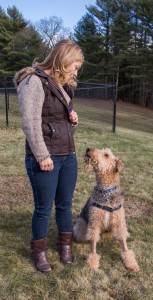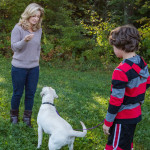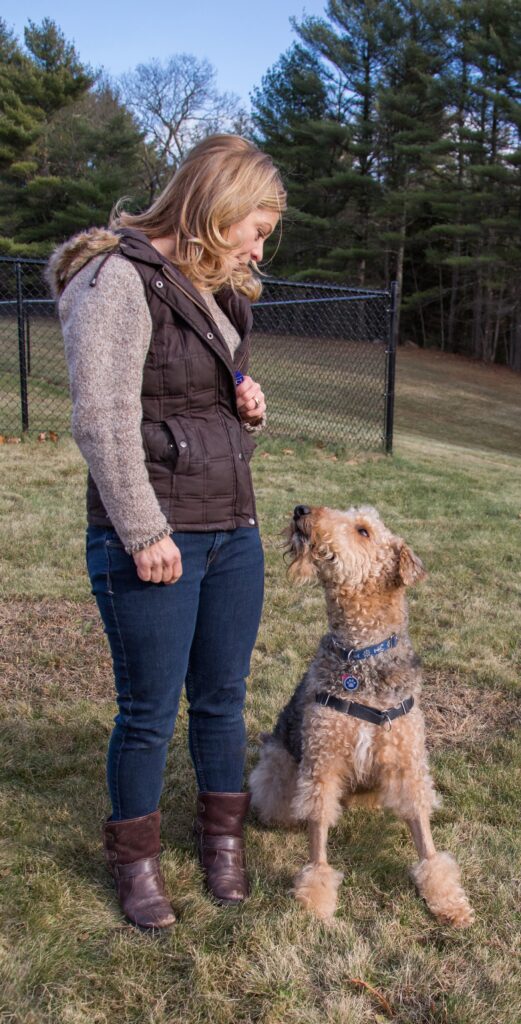There are many ways to get behavior from an animal, for example you can hold your dog down when he jumps up on you, this may work for you, but the negative is that your dog may start barking more when guest arrive. Some dogs will become really wiggly and jumpy with strangers as a way of showing appeasement to the guest to ward off that scary punishment of being held down. This can also make your recall much more difficult as science shows that harsh reprimands can make your dog afraid and avoid you.
Science also shows us that using rewards will get the desired behavior with no negative possible outcome. While it may take a few extra days of training, it is so worth it!
Tip 1: Reward an alternative Behavior
If you do not want your dog to jump on your guest, then teach him a sit stay at your side. Simply walk him forward on a leash while holding a  treat to his nose. When you stop walking move the treat up over his head until he sits, then reward. Repeat this exercise until he automatically sits when you stop walking, then reward for sitting, continue to reward with food then release him. Repeat each morning with his breakfast until he learns to sit/stay next to you while there is no one around. Once he will sit at your side until you release him, then add some guests at a distance. Then practice this behavior outside in the yard, park or vets office. Training a new behavior is best done in a quiet environment, then practiced with low distractions. Remember your dog is most likely an adolescent, so be patient, you were an adolescent once too!
treat to his nose. When you stop walking move the treat up over his head until he sits, then reward. Repeat this exercise until he automatically sits when you stop walking, then reward for sitting, continue to reward with food then release him. Repeat each morning with his breakfast until he learns to sit/stay next to you while there is no one around. Once he will sit at your side until you release him, then add some guests at a distance. Then practice this behavior outside in the yard, park or vets office. Training a new behavior is best done in a quiet environment, then practiced with low distractions. Remember your dog is most likely an adolescent, so be patient, you were an adolescent once too!

Tip 2: Ignore the unwanted behavior
Here is the secret and it is easy! When your puppy jumps up on you, you look away, immediately walk a few steps away from your dog, remember eye contact is rewarding. Call your dog to you and ask for a sit, when he gets it right, reward. If he does an unwanted behavior like jump on you, then walk away with no attention at all. Always give your dog a second chance to earn the reward, otherwise he will not know the wanted behavior.
Tip 3: Put the unwanted behavior on Stimulus Control (for the dog enthusiast)
This can be a little tricky if you do not use a marker in your training, but the idea is that your dog only performs the unwanted behavior when you ask for it. Lets Try it!
If you know your dog is going to jump up on you when you open the door, then you can cue him by  raising both your arms up in the air mark his jump with a “yes” or clicker then reward him. Repeat this around the house until the dog jumps up when you cue him with both your arms in the air. Then add a verbal cue like “up” which you say just before you throw your arms up in the air, always click or use a verbal “yes” when he jumps and reward. This process will take several days, but be patient. Now practice leaving, and re-enter your doorway, cue your dog “up” click and reward for your dog jumping.
raising both your arms up in the air mark his jump with a “yes” or clicker then reward him. Repeat this around the house until the dog jumps up when you cue him with both your arms in the air. Then add a verbal cue like “up” which you say just before you throw your arms up in the air, always click or use a verbal “yes” when he jumps and reward. This process will take several days, but be patient. Now practice leaving, and re-enter your doorway, cue your dog “up” click and reward for your dog jumping.
Over time, cue your dog when you enter the door to “up” then no more cue, as you enter farther in the home, then go out and enter and do not ask for an “up”. If your dog jumps when you do not ask for it, simply walk away with no attention at all. Your dog will learn to only perform the behavior when you ask for it, known as stimulus control training. This is great fun and I recommend you do it for the dog that barks often as well.
Another example: ring your doorbell and say “speak” while looking at your dog, click the second your dog barks and reward. Repeat several times until your dog will offer a bark when you say “speak” without ringing the door bell. Now ring the door bell and after your dog barks, you can say “enough” click and reward when your dog looks at you. I recommend you use a yummy food reward when teaching a new behavior, as the behavior becomes more reliable, you can switch to randomly offering food or affection over time. I have used this same technique on both of my dogs and it works very well!
Send me a video of your success!


